Introduction: How to Use This Book with No Complaints
Negotiate Your Way to Success
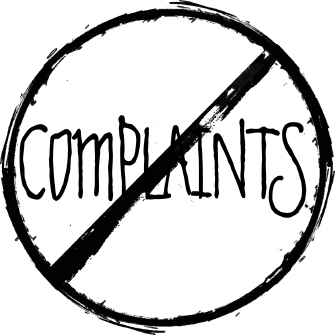
Complainers are energy drainers who create messy, inconvenient work drama. The disruptions they cause involve negative emotions, illogical behavior, irritants, and interruptions to getting your job done. Here are travel tips to help you negotiate your journey through this book with no complaints.
This book is all about spotting problems and fixing them quickly. It helps you spot how your Complainer is causing work drama so that you can stop the behavior and get back to work. Complainers are found at all levels and in all industries.
Occupations of Survey Participants
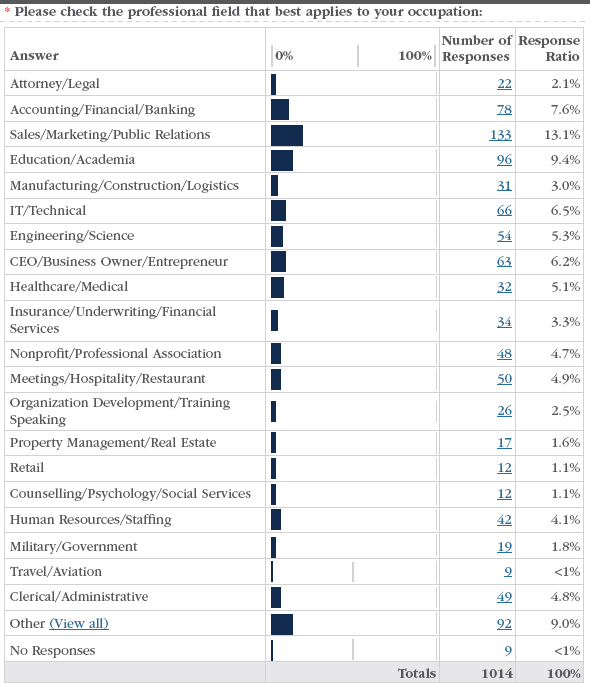
Whether the Complainer is your boss, a peer, or one of your employees, you’ll find examples, explanations of the behavior, conversation strategies, and suggestions to stop the Complainer from generating additional problems. You’ll see negotiating suggestions for all stages of work drama including approaching your leadership for support. The term negotiating is used intentionally throughout this book. Negotiating is a strategic and much stronger approach to stop work drama than managing, dealing with, or handling.
It’s no revelation that complaining is a common occurrence at workplaces. Like others, your top Complainers are probably coworkers and team members, employees who report to you, clients or customers, your boss or people you report to you, family members, or close friends.
Who Complains or Bugs You During the Workday?
Note: Other included telemarketers, students, volunteers, citizens, and union members.
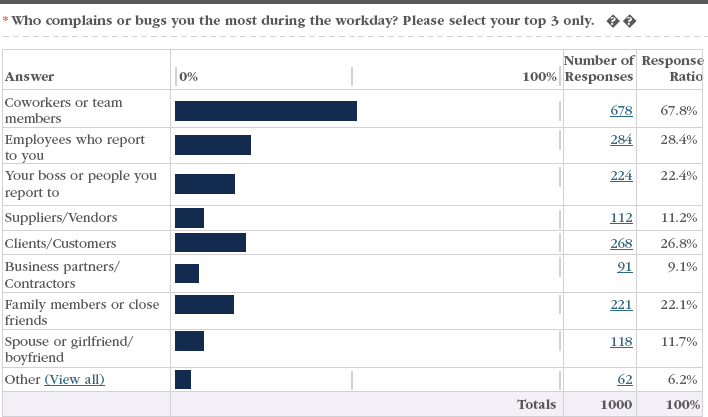
Complaint Department
It’s true. Benefits do result from constructive complaining. However, if you’re reading this book, it is more likely that you are experiencing venting, whining, or griping that isn’t effective but is downright annoying. Chronic Complainers are self-absorbed. Their complaints aren’t helpful. They create a hyper-focus on negative issues. Complainers aren’t concerned with solutions or correcting a dangerous situation. They are focused on themselves. These self-focused agendas generate stress, tension, and depression both in the workplace and at home. Chronic Complainers suck the resources, time, energy, and joy out of work and life. Their top complaints are: too much work to do; unclear direction or lack of feedback from leadership; and incompetent coworkers or boss.
Complainers Complain About These Things
Note: Other included current affairs, politics, economy, taxes, location of work assignments, budget cuts, lack of clients, technology issues, and sports teams.
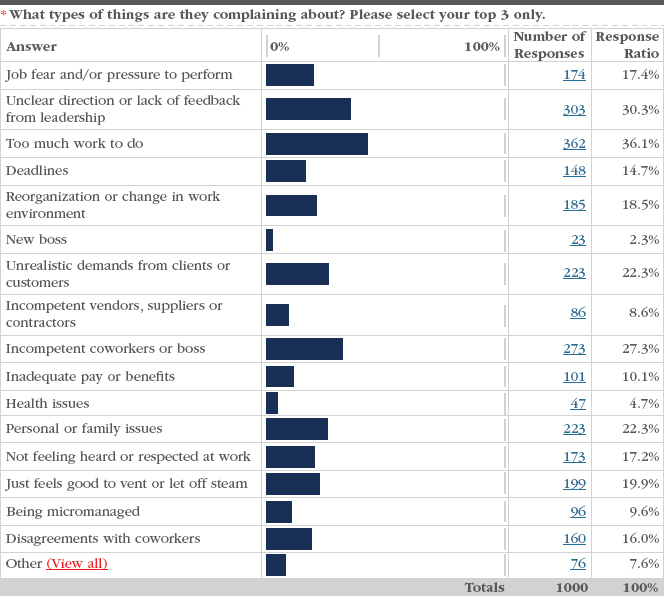
Complainers use whining, complaining, or offensive behavior to gain rewards and/or to avoid some type of pain. For many, their bad behavior has worked since childhood. In fact, chronic Complainers are often compared to school bullies, spoiled toddlers, whiny children, sneaky adolescents, and sullen teenagers. Complainers are called many names.
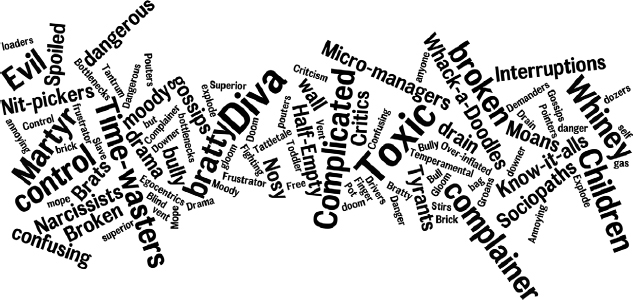
![]()
![]()
Decide on a Direction
You have a choice in how to use this book to your benefit. For example, you can decide to go directly to the chapter that addresses your Complainer’s specific behavior to stop it. Different types of Complainers use complaints very differently. You might be surprised what you uncover. You can look at your Complainer’s reactions, learn the reasons for his or her behavior, and decide the best strategy to negotiate a solution.
There are other ways to use this book to prevent complaining. If you experience work drama from several sources—or if your Complainer has several complaining traits—you may want to read from the beginning to the end. Later, keep this book as a reference manual or a road map for handling future work drama. (Disclaimer: Nothing herein remotely suggests that one of the ways to use this book is to throw it at a Complainer. Despite your frustration, bodily harm is not an acceptable strategy.)
Types of Complainers
First, spot your Complainer’s type with the assessment. One of the surprises of the research was identifying more than one kind of Complainer. In fact, survey respondents identified five types of Complainers. Each type of complaining has its own communication style, including tone, word choice, and accompanying behavior. The five types are seeking different outcomes, from empathy and attention to stability and control. This book gives you specific communication strategies to refocus each Complainer type.
You can identify the types of Complainers by taking the free online assessment to “Spot Your Complainer’s Type.” Then, determine which of the five categories of chronic Complainers you’re facing:
- Whiners complain by showing disapproval, venting, or withdrawing (Chapter 1).
- Complicators employ complaining tactics that frustrate, complicate, and create confusion (Chapter 2).
- Prima Donnas complain by seeking attention, gossiping, creating drama, and stirring up trouble (Chapter 3).
- Controllers use a variety of aggressive complaints in their attempts to reach an outcome, to control situations, and to control people (Chapter 4).
- Toxics are dangerous individuals who use complaints and misinformation to manipulate and poison the environment to further their self-absorbed agendas (Chapter 5).
Road Signs to Help You Negotiate Success
Here are signs you will find throughout the book to help you successfully negotiate your way:
 These common Reactions help you spot each type and provide ideas of the Reality or the reasoning behind that behavior. Identifying some Complainers can be tricky. If all of the behaviors don’t match or if they adopt traits from other types, be prepared to attempt different strategies until you find solutions that work.
These common Reactions help you spot each type and provide ideas of the Reality or the reasoning behind that behavior. Identifying some Complainers can be tricky. If all of the behaviors don’t match or if they adopt traits from other types, be prepared to attempt different strategies until you find solutions that work. These are actions that don’t work to address your Complainers or Energy Drains.
These are actions that don’t work to address your Complainers or Energy Drains. This suggests turning to management or human resources (HR) to ask for help.
This suggests turning to management or human resources (HR) to ask for help. These travel tips help direct you as you move forward to get more work done.
These travel tips help direct you as you move forward to get more work done.Communication Strategies
Spotting the type of Complainer you have is the first step. Communicating in a way that stops the negative behavior is the next. People negotiate with their Complainers in several ways:
Other survey responses included:
In the chapters that follow, you’ll find words to use in negotiating with your Complainer. See what works and what doesn’t. In Vistage, a worldwide development organization for chief executive officers (CEOs) and key decision makers, the members and leaders use the term carefrontation. Carefrontation means “I’m confronting you regarding your behavior or actions in a caring manner.” Or “I care enough about you to give you my observations.” Several “rehabilitated” Complainers said that it took a carefrontation type of conversation to open their eyes that their behavior wasn’t working.
Most chronic Complainers won’t stop complaining without a lot of effort on their part. However, once you understand what kind of Complainer you have, you can develop a strategy to get that Complainer to stop complaining to you!
If You Are the Complainer
It is amazing how many people admit to being a Complainer or a reformed one. If you think you may be a Complainer, take the assessment “Are You Seen as a Complainer?” at www.StopComplainers.com. After you receive the results from your assessment, read more in Chapter 6 to determine which complaining behavior resembles your own. You’ll read about examples of Complainers, good reasons to stop complaining, and effective communication strategies that work to get you what you want.
Research shows that people can become Complainers when faced with Energy Drains. Energy Drains are those environmental factors, organizational constructs, and systems and processes that cause you unnecessary stress. In Chapter 7 you can determine the Energy Drains that are causing you or your people stress. Negotiate the Energy Drains successfully, and that negative complaining behavior and unnecessary drama at work and at home can stop.
Complaining isn’t always a bad thing. Chapter 8 of this book shows you ways to create logical arguments, negotiate work drama, gain support, and be heard by decision makers. You’ll learn how to stop constant complaints without blocking constructive ones, to value information that comes with complaints, and to complain effectively when it’s necessary. These last chapters are dedicated to helping you obtain helpful feedback and improve your odds as you negotiate work drama.
So, You Want More
You have plenty of tools to help you implement what you’ve learned. In the Resources section, you’ll find two “Complain-a-Grams” that you can copy and send anonymously to either your Complainer or a company leader. There is a “Conversation Strategies per Type” table where Complainers are linked to familiar communication styles, such as CORE MAP, DiSC, Myers-Briggs, BrainStyles, and Personal Insight Inventory. This correlation helps you identify development opportunities that can improve coping skills and enhance a Complainer’s natural strengths. You also have “Negotiating Work Drama Checklists” to help you form your strategy and communicate your position effectively.
And please, go to www.StopComplainers.com. There you’ll find additional resources including the assessments, a calculator to help you determine the cost of your Complainers, downloadable “Complain-a-Grams,” checklists, interview questions, articles, and the full survey results. Okay. You have everything you need and more. It is time to start reading and stop complaining!
